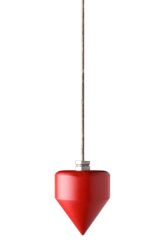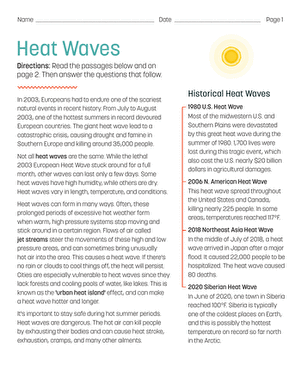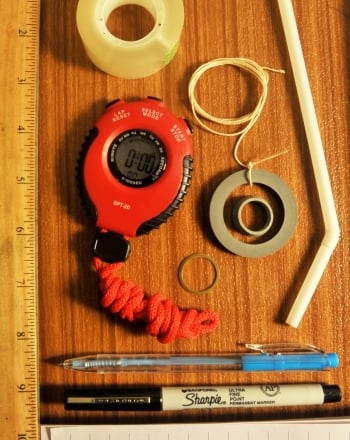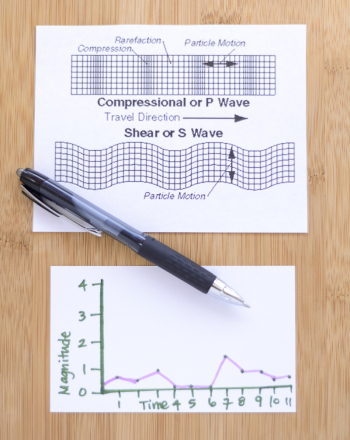Science project
Pendulum Waves
Sometimes, physics can be used to create beautiful art. Kinetic art is art that relies on motion to achieve a specific effect. Often that motion is just an application of simple laws of physics. Waves and harmonic motion (some examples include pendulums and springs) are often great sources of inspiration for creating mesmerizing displays.
In this project, you will use the laws of simple pendulum motion to create a “pendulum wave apparatus”: a device where many pendulums of different lengths (and therefore different periods) start swinging at the same time. As they move in and out of sync, the pendulums create a sequence of cycling visual wave patterns.
Problem
Build a pendulum wave apparatus.
Materials
- 2 meter sticks (or a meter stick and a ruler or tape measure)
- 3.5 meters of string (roughly)
- Nine weights that can be easily attached to a piece of string (e.g. nuts, washers, masses with hooks)
- Tape
- Two stacks of books, each at least one meter high
Procedure
- Cut nine pieces of strings with the following lengths: 44 cm, 41 cm, 39 cm, 37 cm, 35 cm, 33 cm, 31 cm, 30 cm, 29 cm.
- Starting at about the 10 cm mark on the meter stick, tie a piece of string at each point located every 9 cm along the ruler (roughly). Use a small piece of tape to help secure each piece of string to the stick.
- Use the two book stacks to support both ends of the meter stick. The meter stick should make a “bridge” connecting the books.
- Attach one weight to the free end of each string. Thread the string through the hole or hook on each weight and, using your ruler or tape measure, adjust the lengths to exactly match the following table, starting with the longest string. Once you get the lengths right, tie the string to the weight.
|
Pendulum |
1 |
2 |
3 |
4 |
5 |
6 |
7 |
8 |
9 |
|
Length (cm) |
35.7 |
33.0 |
30.6 |
28.5 |
26.6 |
24.8 |
23.2 |
21.8 |
20.5 |
- Once you have all nine pendulums constructed, use the ruler (or a large book or even your arm) to scoop all the pendulums towards you by a few inches.
- Let all the pendulums go at once so that they swing perpendicular to the meter stick from which they are hanging.
- Enjoy the show! It’s best to watch the pendulums either from above (looking down) or from one end of the meter stick (viewed along its length). How many different patterns do you see? Does anything repeat? If any patterns do repeat, how long does it take for them to do so?
Results
The pendulum ensemble will cycle through a number of patterns over a 30 second interval. You’ll see everything in sync, pendulum waves of varying lengths rippling down the line, alternating swings (half the pendulums going one direction, half going the other), and even seemingly chaotic motion.
Why?
The lengths of the pendulums are designed so that all of them complete a different whole number of swings every 30 seconds. The first (longest) pendulum swings 25 times in 30 seconds, the next one 26 times, the next one 27, and so on; the final (shortest) pendulum completes 33 swings in the same interval. This means that every 30 seconds, all the pendulums will swing to one side together.
Everything that happens in the middle of this interval is a stunning display of many pendulums, each with a slightly shorter period than the previous one, moving in and out of phase with one another. As the shorter pendulums start getting ahead of the longer ones, they slightly “lead” the ones next to them and create a wave effect along the meter stick. At 15 seconds—halfway through the 30-second cycle—every other pendulum (starting with the second longest) will have completed a whole number of cycles, while the remaining pendulums are all synced together at a “half cycle”. When this happens, half the pendulums are all grouped together on one side, with the remaining pendulums grouped together on the other side.
Going Further
You can modify the apparatus to add more pendulums or create a longer cycle than 30 seconds. The trick is to first decide how long you want the overall cycle to be (we used 30 seconds in this design, but it can be as long as you like). Then, decide how many times you want the longest pendulum to swing back and forth in that interval. With that in mind, the period of each successive pendulum has to be set so that it swings one more time than the previous one in the same interval.
Remember that the period of an ideal pendulum depends only on its length:

- where g = 9.8 m/s is the acceleration due to gravity,
- L is the pendulum length (in meters), and
- T is the period in seconds.
The number of times (N) a pendulum will swing in the overall cycle is represented by

- where Tmax is the overall cycle length in seconds.
Alternatively, you can use the following shortcut to design your own pendulum wave apparatus:

…which tells you the length, L(n), of the n-th pendulum, where k is the number of cycles the whole apparatus goes through before repeating the pattern.
Education.com provides the Science Fair Project Ideas for informational purposes only. Education.com does not make any guarantee or representation regarding the Science Fair Project Ideas and is not responsible or liable for any loss or damage, directly or indirectly, caused by your use of such information. By accessing the Science Fair Project Ideas, you waive and renounce any claims against Education.com that arise thereof. In addition, your access to Education.com's website and Science Fair Project Ideas is covered by Education.com's Privacy Policy and site Terms of Use, which include limitations on Education.com's liability.
Warning is hereby given that not all Project Ideas are appropriate for all individuals or in all circumstances. Implementation of any Science Project Idea should be undertaken only in appropriate settings and with appropriate parental or other supervision. Reading and following the safety precautions of all materials used in a project is the sole responsibility of each individual. For further information, consult your state's handbook of Science Safety.












